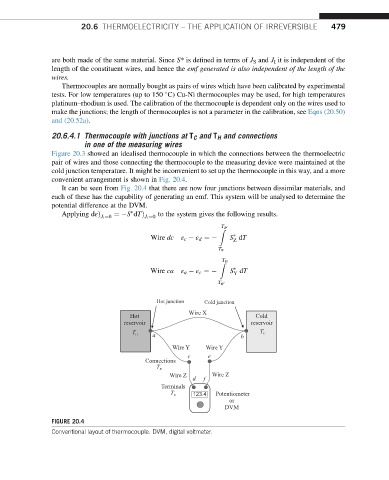Page 487 - Advanced thermodynamics for engineers
P. 487
20.6 THERMOELECTRICITY – THE APPLICATION OF IRREVERSIBLE 479
are both made of the same material. Since S* is defined in terms of J S and J I it is independent of the
length of the constituent wires, and hence the emf generated is also independent of the length of the
wires.
Thermocouples are normally bought as pairs of wires which have been calibrated by experimental
tests. For low temperatures (up to 150 C) Cu-Ni thermocouples may be used, for high temperatures
platinum–rhodium is used. The calibration of the thermocouple is dependent only on the wires used to
make the junctions; the length of thermocouples is not a parameter in the calibration, see Eqns (20.50)
and (20.52a).
20.6.4.1 Thermocouple with junctions at T C and T H and connections
in one of the measuring wires
Figure 20.3 showed an idealised thermocouple in which the connections between the thermoelectric
pair of wires and those connecting the thermocouple to the measuring device were maintained at the
cold junction temperature. It might be inconvenient to set up the thermocouple in this way, and a more
convenient arrangement is shown in Fig. 20.4.
It can be seen from Fig. 20.4 that there are now four junctions between dissimilar materials, and
each of these has the capability of generating an emf. This system will be analysed to determine the
potential difference at the DVM.
Applying dεÞ J I ¼0 ¼ S dTÞ J I ¼0 to the system gives the following results.
T
Z R 0
Wire dc ε c ε d ¼ S dT
Z
T R
T
Z H
Wire ca ε a ε c ¼ S dT
Y
T R 0
Hot junction Cold junction
Wire X
Hot Cold
reservoir reservoir
a b
T H T C
Wire Y Wire Y
c e
Connections
T R'
Wire Z Wire Z
d f
Terminals
T R 123.4 Potentiometer
or
DVM
FIGURE 20.4
Conventional layout of thermocouple. DVM, digital voltmeter.

